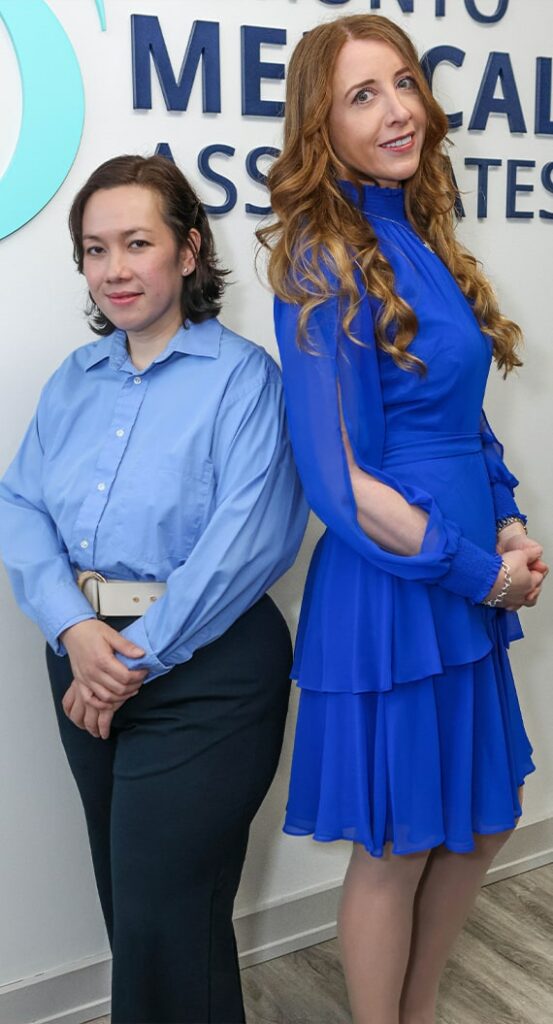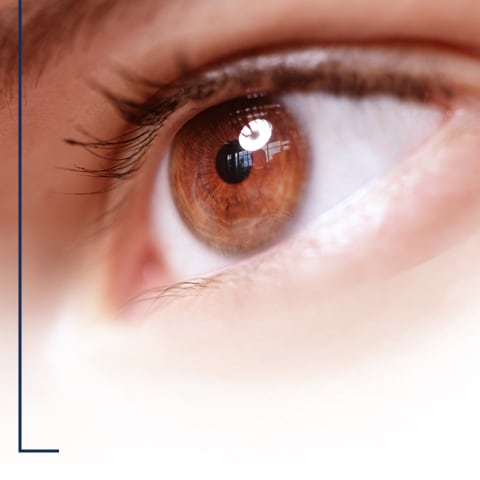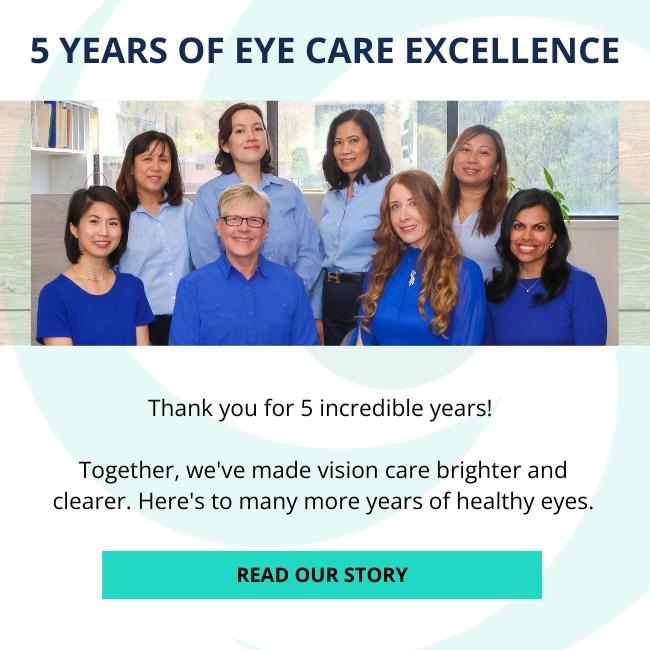Finding Relief from Dry Eyes

Dry eye disease is a chronic disease that can gradually progress over time. At Toronto Medical Eye Associates, we strive to help you manage dry eyes with various treatment options.
Our team is here to help alleviate the symptoms and discomfort that come along with dry eyes. Contact us and book an appointment to get the dry eye relief you deserve.

What Is Dry Eye Disease?
Dry eye disease can occur when your tears do not provide enough lubrication for your eyes or if you produce poor-quality tears. This tear instability leads to inflammation and can damage your eye’s surface.
Common signs and symptoms of dry eye disease can include:
- Eye redness and swelling
- Stinging and burning
- Sensitivity to light
- Blurred vision
- Eye fatigue
Risk factors for dry eye disease can include:
- A poor diet
- Chronic allergies
- Environmental factors such as exposure to the wind or dry air
In today’s world, using digital devices can speed up the progression of dry eye disease, and prevention is the key to finding relief.
Check out this CBC video featuring Dr. Rana Taji on how screen time is affecting your eyes.

Dry Eye Disease Management
A dry eye assessment is an essential step to getting you the treatment you deserve. Our team uses diagnostic technology to help manage and treat your dry eye symptoms.
Ocular Surface Disease Assessment
An ocular surface disease assessment is an exam that addresses the signs and symptoms related to dry eye disease.
Dr. Taji focuses on dry eye disease and thoroughly assesses the structures of the eyes that are affected to uncover the source of the dry eye problem. A treatment plan is then developed for a patient’s unique needs.
The treatment plan is based on the severity of the disease and the patient’s lifestyle needs. Follow-up care to track progress with treatment will ensue once therapy is initiated.
An ocular surface disease assessment can include:
- A validated dry eye disease index questionnaire quantifying symptoms.
- A thorough evaluation and grading of the health of the lid and lash margin. Grading scales are used to document a baseline, develop a suitable treatment plan, and compare in future assessments for improvement in signs and symptoms.
- Infrared grading (Meibography) and examination of the health of the meibomian gland function. Meibomian glands line the lower and upper lids. These glands are instrumental in providing stability to the tear film. When these glands cannot excrete the secretions within them properly, the glands become blocked, thereby leading to symptoms of dry eye disease. Assessing the health of these glands is crucial in not only to prevent them from degenerating but to continue to maintain optimal eye health. It is estimated over 80% of dry eye disease originates from meibomian gland dysfunction.
- A thorough assessment of the conjunctiva’s health, the eye’s white part. Dry eye disease can change the DNA of the conjunctiva. By utilizing various tests, this can aid us in determining the severity of the dry eye disease state.
- Assessing and grading the health of the cornea.
- Quantitative and qualitative tear film assessment, including tear break-up time, volume, etc.
Radio Frequency (RF) Forma by Inmode
The latest addition to our dry eye treatment modality, known as Forma, takes advantage of radio frequency technology.
Initially used in dermatology to tighten skin, Forma has found a new use in eye health as a treatment for dry eye disease. Forma works by applying radio waves to your skin which penetrate deeply and warm the tissue—resembling a warm facial massage.
Traditional heat therapy reaches the glands but on a much more superficial level. In contrast, Forma penetrates much deeper, allowing the secretions to break up. This process softens the thickened oils deep in your glands and allows the doctor to express them, restoring their natural function as tightening skin and reducing the look of fine lines and wrinkles.
Best results are achieved with 4 consecutive sessions 2 weeks apart.
Intense Pulsed Light (IPL) Lumeca by Inmode
Intense pulsed light is a therapy that penetrates the eyelid tissue, heating it up, and reducing inflammation associated with meibomian gland dysfunction, dry eye disease, ocular rosacea, and more.
Repeated pulses are administered in each session, with little to no down time following the treatment. IPL treatment is most effective with back-to-back sessions every 2 weeks for a total of 4 sessions for maximum results.
Meibomian Gland Expression/Debridement
Meibomian gland expression/debridement is an in-office procedure following the thermal heating of the glands. The doctor manually expresses the upper and lower glands, also known as meibomian glands, to allow secretions to flow easily. This process prevents the glands from clogging and leading to atrophy.
The procedure has been adapted for patients suffering from milder forms of gland dysfunction to help excrete the waste that is plugged up in the glands. First, we use heat therapy to warm up the glands, then the maskin instrument to express, followed by a spud-like instrument to clean up the secretions expressed. The eyes are numbed to decrease discomfort.
There is no downtime and no side effects from the procedure. The eyes may feel irritated for 24 to 48 hours following the treatment.
This procedure is recommended every 3 to 4 months to allow the glands to flow properly and allow proper secretion to maintain a proper balance of the tear film structure.
Blepharomicroexfoliation Procedure Using the Blephex Instrument
The blepharomicroexfoliation procedure is an in-office procedure to reduce the bacterial load and Demodex mites associated with a condition called blepharitis. This is a condition whereby mites build up and live in the lids and lashes and cause significant instability to the tear film, thereby leading to dry eye disease.
Risk factors associated with this condition include:
- Diet
- Use of fake eyelashes
- Dermatological conditions such as rosacea and fair skin
This procedure is a highly effective treatment to reduce Demodex mite (lice) and bacterial buildup in the lid margins. Proper maintenance following the procedure can result in a healthy ocular surface with minimal to no eye irritation.
Thermal heating of meibomian glands in combination with debridement expression treatment and/or blepharomicroexfoliation for maximal results with keeping the eyes’ front surface clean.
Intraductal Meibomian Gland Probing
Intraductal meibomian gland probing involves numbing the eyes and lids to decrease patient discomfort, individually probing every gland on the lower and upper lid to clear up blockages, followed by an expression of the glands. This process is used for more severe cases of meibomian gland dysfunction. The eyes may feel irritated for 48 to 72 hours following the procedure.
A key element of gland blockage is attributable to scarring. This scarring constricts the duct by growing circumferentially around it, creating resistance inside the duct that blocks adequate oil flow and elevates pressure within the gland. This additional pressure results in lid tenderness, inflammation, and gland atrophy.
Scarring may occur at various points along the gland, allowing glands to be partially functional in oil secretion or entirely blocked. This critical discovery explains why glands may produce some oil but still not be healthy. The images of glands presented above illustrate these principles.
Without releasing the duct of this scar tissue before further treatment, this nonvisible problem only deteriorates more rapidly and exacerbates the severity of symptoms and, by extension, depth of psychosocial impacts like stress, anxiety, depression, and even suicidal ideations.
Amniotic Membrane
An amniotic membrane is a stem cell therapy that helps improve healing when the cornea is compromised due to a number of conditions such as:
- Severe dry eye disease
- Superficial corneal injuries
- Corneal ulcers
- Recurrent corneal erosions
- Chemical burns to the cornea
The amniotic membrane is part of the placenta. It is the tissue closest to the baby throughout development in the womb. The amniotic membrane protects the baby from harm and has natural biologic actions that help the baby develop. The tissue has biological properties that aid in ocular surface repair.
Low Level Light Therapy
Low level light therapy is a treatment safe for all skin types that utilizes high wavelength, low energy light to offer an anti-inflammatory effect for dry eye disease. It uses both red light and near infrared light. Red light offers a more superficial treatment whereas near infrared light is more applicable for deeper penetration into the cells. It improves cellular metabolism by increasing ATP production (energy) within the mitochondria (Tian). Mitochondria is the powerhouse of the cells in the body. Inflammation is reduced through up-regulation of anti-oxidant defenses and by reducing oxidative stress, light induced activation of transcription factors and signaling pathways is stimulated (Tian)
What are the results of Low Level Light Therapy?
- Anti-oxidation occurs, improving lymphatic flow.
- Increase of nitric oxide circulation
- Dilates blood vessels
- Burst of ROS (reactive oxygen species)
- Cascade of down regulation
Reference: Tian, Fenghua et al. “Transcranial laser stimulation improves human cerebral oxygenation.” Lasers in surgery and medicine vol. 48,4 (2016): 343-9. doi:10.1002/lsm.22471
Autologous Serum Drops
These are custom drops created using a patient’s own blood serum and plasma. The fluid created contains epithelium-promoting growth factors and other essential components present in natural tears. Autologous serum drops can be used to treat severe dry eyes by encouraging eyes to produce more natural tears.
Platelet Rich Plasma Drops
These are custom drops created using a patient’s own plasma. Platelets contain many natural growth factors that promote regeneration of epithelial cells that activate in response to damaged tissue. Platelet Rich Plasma Drops can be used to treat severe dry eyes to aid with regeneration and healing of certain cells and structures within the cornea and tear film.
Get the Dry Eye Treatment You Deserve

Dry eye disease can cause discomfort and put a halt to your productivity. At Toronto Medical Eye Associates, we want to help you find relief and treatment as soon as possible.
Contact us to book an appointment and get the dry eye treatment you deserve.
Our Services
Say Goodbye to Dry Eye
Do you suffer from dry eye symptoms?
Dry eye is a common condition that can cause your eyes to feel uncomfortable and irritated. Don’t let dry eye stop you from living your life. Dr. Taji is a trusted voice on dry eye disease and has hosted many lectures and presentations on diagnosis and treatment.
You can feel confident in your dry eye treatment with our team. Contact us today to book your dry eye evaluation and get relief sooner.
Our Location
You’ll find our clinic around the corner from North York General Hospital, just up from the Don River and Betty Sutherland hiking trail.
Please don’t hesitate to contact us if you have any trouble finding us!

Our Address
- 1333 Sheppard Avenue East, Suite 343
- North York, Ontario M2J 1V1
Contact Information
- 416-494-2020
- 416-494-0010
- [email protected]
Our Hours
- Monday – Thursday: 8:30 AM – 5:00 PM
- Friday: 8:30 AM – 12:00 PM
- Saturday & Sunday: Closed







